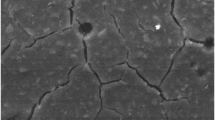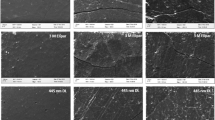Abstract
This in vitro study aimed to determine whether the micro-hardness of a composite resin is modified by the light units or by the thickness of the increment. Composite resin disks were divided into 15 groups (n = 5), according to the factors under study: composite resin thickness (0 mm, 1 mm, 2 mm , 3 mm and 4 mm) and light units. The light activation was performed with halogen light (HL) (40 s, 500 mW/cm2), argon ion laser (AL) (30 s, 600 mW/cm2) or light-emitting diode (LED) (30 s, 400 mW/cm2). Vickers micro-hardness tests were performed after 1 week and were carried out on the top surface (0 mm—control) and at different depths of the samples. Analysis of variance (ANOVA) and Tukey tests (P ≤ 0.05) revealed no statistically significant difference among the light units for the groups of 0 mm and 1 mm thickness. At 2 mm depth, the AL was not statistically different from the HL, but the latter showed higher micro-hardness values than the LED. In groups with 3 mm and 4 mm thickness, the HL also showed higher micro-hardness values than the groups activated by the AL and the LED. Only the HL presented satisfactory polymerization with 3 mm of thickness. With a 4 mm increment no light unit was able to promote satisfactory polymerization.


Similar content being viewed by others
References
Rahiotis C, Kakaboura A, Loukidis M, Vougiouklakis G (2004) Curing efficiency of various types of light-curing units. Eur J Oral Sci 112: 89–94
De Wald JP, Ferracane JL (1987) A comparison of four modes of evaluating depth of cure of light-activated composites. J Dent Res 66: 727–730
Yearn JA (1985) Factors affecting cure of visible light activated composites. Int Dent J 35:218–225
Ferracane JL (1985) Correlation between hardness and degree of conversion during the setting reaction of unfilled dental restorative resins. Dent Mater 1:11–14
Ferracane JL, Greener EH (1986) The effect of resin formulation on the degree of conversion and mechanical properties of dental restorative resins. J Biomed Mater Res 20:121–131
Knobloch LA, Kerby RE, Clelland N, Lee J (2004) Hardness and degree of conversion of posterior packable composites. Oper Dent 29:642–649
Powell GL (1992) Lasers in the limelight: what will the future bring? J Am Dent Assoc 123:71–74
Powell GL, Blankenau RJ (2000) Laser curing of dental materials. Dent Clin North Am 44:923–930
Vandewalle KS, Roberts HW, Tiba A, Charlton DG (2005) Thermal emission and curing efficiency of LED and halogen curing lights. Oper Dent 30:257–264
Peris AR, Mitsui FHO, Amaral CM, Ambrosano GMB, Pimenta LAF (2005) The effect of composite type on micro-hardness when using quartz-tungsten-halogen (QTH) or LED lights. Oper Dent 30:649–654
Katahira N, Foxton RM, Inai N, Otsuki M, Tagami J (2004) Comparison of PAC and QTH light sources on polymerization of resin composites. Am J Dent 17:113–119
Tsai PC, Meyers IA, Walsh LJ (2004) Depth of cure and surface micro-hardness of composite resin cured with blue LED curing lights. Dent Mater 20:364–369
Bala O, Ölmez A, Kalayci S (2005) Effect of LED and halogen light curing on polymerization of resin-based composites. J Oral Rehabil 32:134–140
Blankenau RJ, Kelsey WP, Powell GL, Shearer GO, Barkmeier WW, Cavel WT (1991) Degree of composite resin polymerization with visible light and argon laser. Am J Dent 4:40–42
Kelsey WP, Blankenau RJ, Powell GL (1991) Application of the argon laser to dentistry. Lasers Surg Med 11:495–498
Cunha LG, Sinhoreti MAC, Consani S, Correr-Sobrinho L (2003) Effect of different photoactivation methods on the polymerization depth of a light-activated composite. Oper Dent 28:155–159
Lloret PR, Rode KM, Turbino ML (2004) Dentine bond strength of a composite resin polymerized with conventional light and argon laser. Braz Oral Res 18:271–275
Nomoto R, Uchida K, Hirasawa T (1994) Effect of light intensity on polymerization of light cured composite resins. Dent Mater J 12:198–205
Kelsey WP 3rd, Blankenau RJ, Powell GL, Barkmeier WW, Cavel WT, Whisenant BK (1989) Enhancement of physical properties of resin restorative materials by laser polymerization. Lasers Surg Med 9:623–627
Rode KM, Kawano Y, Turbino ML (2007) Evaluation of curing light distance on resin composite micro-hardness and polymerization. Oper Dent 32:571–578
Watts DC, Amer OM, Combe EC (1987) Surface hardness development in light-cured composites. Dent Mater 3:265–269
Atmadja G, Bryant RW (1990) Some factors influencing the depth of cure of visible light-activated composite resins. Aust Dent J 35:213–218
Mandarino F, Angelis Porto CL, Fontana UF, Cândido MSM, Oliveira OB Jr (1992) Efeito da tonalidade de cor sobre a profundidade de polimerização das resinas compostas fotopolimerizáveis. Rev Bras Odontol 49:38–41
Rueggeberg FA, Caughman WF, Curtis JW Jr (1994) Effect of light intensity and exposure duration on cure of resin composite. Oper Dent 19:26–32
Rueggeberg FA, Ergle JW, Mettenburg DJ (2000) Polymerization depths of contemporary light-curing units using micro-hardness. J Esthet Dent 12:340–349
Tarle Z, Meniga A, Ristic M, Sutalo J, Pichler G (1998) The effect of photopolymerization method on the quality of composite samples. J Oral Rehabil 25:436–442
Peutzfeldt A, Sahafi A, Asmussen E (2000) Characterization of resin composites polymerized with plasma arc curing units. Dent Mater 16:330–336
Frentzen M, Koort HJ (1990) Lasers in dentistry: new possibilities with advancing laser technology? Int Dent J 40:323–331
Docktor MH (1994) Esthetics and the argon ion laser. J Esthet Dent 6:77–82
Wakinine S, Cipolla AJ (1995) Laser vs halogen photopolymerization—characterization of VLC composite mechanical properties. J Dent Res 74:230 (Abstract 1745)
Cobb DS, Vargas MA, Rundle T (1996) Physical properties of composites cured with conventional light or argon laser. Am J Dent 9:199–202
Vargas MA, Cobb DS, Schmit JL (1998) Polymerization of composite resins: argon laser vs conventional light. Oper Dent 23:87–93
Verheyen P (2001) Photopolymerization with the argon laser. J Oral Laser Appl 1:49–54
Burgess JO, Walker RS, Porche CJ, Rappold AJ (2002) Light-curing—an update. Compendium 23:889–906
Hammesfahr PD, O’Connor MT, Wang X (2002) Light-curing technology: past, present and future. Comp Contin Educ Dent 23:18–24
Lohbauer U, Rahiotis C, Krämer N, Petschelt A, Eliades G (2005) The effect of different light-curing units on fatigue behavior and degree of conversion of a resin composite. Dent Mater 21:608–615
Powell GL, Anderson JR, Blankenau RJ (1999) Laser and curing light induced in vitro pulpal temperature changes. J Clin Laser Med Surg 17:3–5
Dunn WJ, Bush AC (2002) A comparison of polymerization by light-emitting diode and halogen-based light-curing units. J Am Dental Assoc 133:335–341
Acknowledgments
The authors would like to express their gratitude to Dr. Carlos de Paula Eduardo for his critical comments. They would also like to thank the Special Laboratory of Lasers in Dentistry at the University of São Paulo and to 3MESPE (Brazil) for their contribution. This investigation was also supported by the State of São Paulo Research Foundation/FAPESP, grants 99/08433-4 and 99/11408-1.
Author information
Authors and Affiliations
Corresponding author
Rights and permissions
About this article
Cite this article
Rode, K.M., de Freitas, P.M., Lloret, P.R. et al. Micro-hardness evaluation of a micro-hybrid composite resin light cured with halogen light, light-emitting diode and argon ion laser. Lasers Med Sci 24, 87–92 (2009). https://doi.org/10.1007/s10103-007-0527-x
Received:
Accepted:
Published:
Issue Date:
DOI: https://doi.org/10.1007/s10103-007-0527-x




